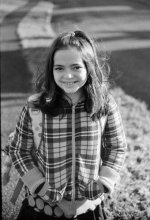dont give up
dont give up
This picture here is similar to your initial digital picture (focus on eyes, bokeh, color), but shot on film with a Canon QL17 GIII.
To get this picture (which looks as good as any higher iso digital to me), a lot of things have to work.
Everyone's advice is correct, and here are my few cents.
First, your camera has to work correctly. Shutter times and rangefinder alignment need to be spot on, and the older cameras (believe me, I have too many) are hit or miss without a cla.
Second, I used Fuji iso100 film. And even still the negative will never be as "clean" as a digital file. That's just how it goes with film.
Third, the processing (assuming you exposed the image like you wanted) is important. I do all of my processing at home, so I can better control the process and prevent scratches.
Fourth, scanning the image and post processing is an art unto itself. This was scanned on a plustek 7300, and then the curves were played with to get the image to look like I want. This image was not sharpened after scanning.
It's not especially difficult, but the stars kind of have to align, and then each step along the way has to be done correctly. Film is just a longer process with more places to mess up than digital. Keep going at it and you'll get results you like.





